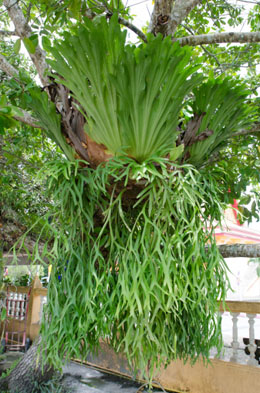An amazing plant with antler-shaped fronds, the staghorn fern can be grown easily. Go through this article for a brief overview about the plant.

If you like to grow strange and unusual plants in your garden, then staghorn fern can be one of the ideal options. Otherwise known as elkhorn fern, this plant got its name from the unusual shape of its leaves. The fronds (compound leaves of a fern) of this fern have the shape of stag antlers.
There are around 18 species of staghorn ferns, and they belong to the genus
Platycerium in the family
Polypodiaceae. The different species include
Platycerium andinum,
Platycerium elephantotis,
Platycerium bifurcatum,
Platycerium holttumii,
Platycerium ridleyi,
Platycerium alcicorne, and
Platycerium wallichii. Among them,
Platycerium bifurcatum is most commonly grown as houseplant.
Features
These ferns are natives to the tropical and temperate regions of South America, Africa, Southeast Asia, Australia, and New Guinea. In their native habitat, these ferns grow as epiphytes. In other words, they are not parasitic, but grow on other plants and trees, and derive nutrients from the air and rain.
Staghorn ferns are found to grow on tree trunks and rocks. They attach themselves to the host tree with the help of their roots. They have two types of fronds; basal and foliar. The basal leaves are often found to be round or kidney-shaped, and are sterile. These thick leaves grow in overlapping layers, and are often found to cover the growing surfaces, so as to protect the roots. The lobes on the upper parts of these leaves collect rainwater, plant debris, and fallen leaves. Once these things break down, nutrients will be released, and they are absorbed by the plant.
Foliar fronds are also called fertile fronds, and they are erect or pendant. The undersides of the foliar fronds produce brownish reproductive structures, which are called sporangia. They produce spores which in turn germinate to new plants.
How to Care for a Staghorn Fern
These ferns are not like regular plants, and they need special care for a healthy growth. These non-flowering plants are perfect for adding some greenery to your garden. If you are living in warm climates, you can grow these plants outdoors. Otherwise, keep them indoors. As houseplants, staghorn ferns are usually mounted on sturdy boards or in hanging baskets.
Mounting: Choose a strong piece of hardwood. Fix a heavy-duty hook on the back of the hardwood, so that it can be secured to the wall. Place some pre-soaked sphagnum moss (remove excess water) on the center of the hardwood, and keep the fern above that (the fronds must point upwards). Fix two small nails on either side of the moss with the fern above it. Use a fishing line to interconnect the nails, thereby crisscrossing and covering the moss and fern. This is necessary to keep the fern intact. As the fern grows, the fishing line will get covered. You can hang this in a location with bright, indirect light.
Other Requirements: Once you are done with the planting, you have to take special care with regard to other factors, like watering, temperature, and feeding. Watering is done by dipping the root ball and the bark in water, for around 15 minutes, during spring and fall. During winters, the duration must be reduced to a few minutes. However, watering has to be done, when both the roots and bark are completely dry. As temperatures below 55° F are not good for this plant, try to maintain higher temperatures. A temperature setting of 65° F or above, is found to be best for staghorns. You may also attach additional barks for the roots to grow. Even misting of the leaves can be done on a weekly basis. The leaves must not be kept damp for a long time.
During the growing season, a water soluble formula can be used on small plants. For established ones, time release fertilizers can be used. Staghorn fern propagation is usually done by removing and planting the saplings produced by the mother plants. These saplings have to be removed carefully along with some moss, and have to be planted as per the method discussed above.
In short, growing staghorn ferns is not a difficult task, but you must know the right methods. So, contact your local nursery, and get one for your garden.






 If you like to grow strange and unusual plants in your garden, then staghorn fern can be one of the ideal options. Otherwise known as elkhorn fern, this plant got its name from the unusual shape of its leaves. The fronds (compound leaves of a fern) of this fern have the shape of stag antlers.
If you like to grow strange and unusual plants in your garden, then staghorn fern can be one of the ideal options. Otherwise known as elkhorn fern, this plant got its name from the unusual shape of its leaves. The fronds (compound leaves of a fern) of this fern have the shape of stag antlers.